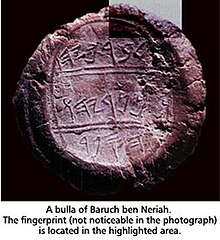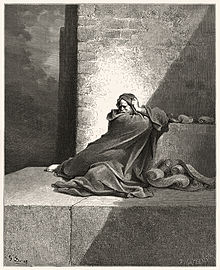Baruch ben Neriah
Baruch | |
|---|---|
Promptuarii Iconum Insigniorum (1553). | |
| Prophet, Righteous | |
| Honored in | Judaism Christianity |
| Feast | 28 September 15 November |
| Major works | Book of Baruch |
Baruch ben Neriah (Hebrew: בָּרוּךְ בֶּן־נֵרִיָּה Bārūḵ ben Nērīyyā; c. 6th century BC) was the scribe, disciple, secretary, and devoted friend of the Biblical prophet Jeremiah. He is traditionally credited with authoring the Book of Baruch.[1]
Biography
According to
Baruch became the scribe of the prophet Jeremiah and wrote down the first and second editions of his prophecies as they were dictated to him.
Both Baruch and Jeremiah witnessed the Babylonian siege of Jerusalem of 587–586 BC. In the middle of the siege of Jerusalem, Jeremiah purchased an estate in Anathoth on which the Babylonian armies had encamped (as a symbol of faith in the eventual restoration of Jerusalem; Jeremiah 32) and, according to Josephus, Baruch continued to reside with him at Mizpah.[3]
He was carried with Jeremiah to Egypt, where, according to a tradition preserved by Jerome,[6] he soon died. Two other traditions state that he later went, or was carried, to Babylon by Nebuchadnezzar II after the latter's conquest of Egypt.
Baruch's prominence, by reason of his intimate association with Jeremiah, led later generations to exalt his reputation still further. To him were attributed the Book of Baruch and two other Jewish books.[a]
Historicity

In 1975, a clay
| Line | Transliteration | Translation |
|---|---|---|
| 1 | lbrkyhw | [belonging] to Berachyahu |
| 2 | bn nryhw | son of Neriyahu |
| 3 | hspr | the scribe |
In 1996, a second clay bulla emerged with an identical inscription; presumably stamped with the same seal. This bulla also was imprinted with a fingerprint;[10] Hershel Shanks, among others, speculated that the fingerprint might be that of Baruch himself;[11][12] the authenticity of these bullae however has been disputed.ibid.
Scholarly theories
In the second edition of
Religious traditions
Rabbinical literature

The
The
, and the Holy Spirit rested upon him. Why is it otherwise with me?" God answered him: "Baruch, of what avail is a hedge where there is no vineyard, or a shepherd where there are no sheep?" Baruch, therefore, found consolation in the fact that when Israel was exiled to Babylonia there was no longer occasion for prophecy.The Seder Olam (xx.), however, and the Talmud,[20] include Baruch among the Prophets, and state that he prophesied in the period following the destruction. It was in Babylonia also that Ezra studied the Torah with Baruch. Nor did he think of returning to Judea during his teacher's lifetime, since he considered the study of the Torah more important than the rebuilding of the Temple;[21] and Baruch could not join the returning exiles by reason of his age.[22]
Christian traditions

Some Christian legends (especially from Syria and Arabia) identify Baruch with Zoroaster, and give much information concerning him. Baruch, angry because the gift of prophecy had been denied him, and on account of the destruction of Jerusalem and the Temple, left Israel to found the religion of Zoroaster. The prophecy of the Virgin birth of Jesus, and of the Adoration of the Magi, is also ascribed to Baruch-Zoroaster.[b] It is difficult to explain the origin of this curious identification of a prophet with a magician, such as Zoroaster was held to be, among the Jews, Christians, and Arabs. De Sacy[23] explains it on the ground that in Arabic the name of the prophet Jeremiah is almost identical with that of the city of Urmiah, where, it is said, Zoroaster lived.
However, this may be, the Jewish legend mentioned above (under Baruch in Rabbinical Literature), according to which the Ethiopian in Jeremiah 38:7 is undoubtedly identical with Baruch, is connected with this Arabic–Christian legend. In the
In the
The
Some sources set a date for his commemoration on 21 October.[32]
Tomb of Baruch
The tomb of Baruch is unknown. It is reported to be a mile away from that of
However, there is a tomb within the Al-Nukhailah Mosque in Al-Kifl dedicated to Baruch.[37] Corresponding with the earlier legend, it is located near to the Tomb of Ezekiel, which is also in the same building.
See also
References
Notes
- ^ See Apocalypse of Baruch
- ^ Compare the complete collection of these legends in Gottheil 1894, pp. 24–51 and Jackson 1899, pp. 17, 165-
Citations
- ^ Gigot 1907.
- ^ Jeremiah 51:59
- ^ a b Josephus. Antiquities of the Jews. 10.9.1..
- ^ Holman 2011, p. 65.
- ^ Jeremiah 36:1–8
- ^ Isaiah 30:6–7
- ^ Avigad 1979, pp. 114–118.
- ^ Shanks 1987, pp. 58–65.
- ^ Avigad 1979, p. 118.
- ^ Shanks 1996, pp. 36–38.
- ^ Goren 2005, pp. 1–8.
- ^ Vaughn & Rollston 2005, pp. 61–65.
- incomplete short citation]
- ^ Jeremiah 38:7
- incomplete short citation]
- incomplete short citation]
- incomplete short citation]
- incomplete short citation]
- ^ Jeremiah 45:3
- incomplete short citation]
- incomplete short citation]
- incomplete short citation]
- incomplete short citation]
- ^ Clement 1890, p. 140, iv. 27.
- ^ Clement 1890, p. 141, iv. 28.
- incomplete short citation]
- ^ 2 Kings 2:11
- ^ Solomon (Bishop of Basra) & Wallis Budge 1886, p. 90.
- ^ "The Stages of Revelation". Catechism of the Catholic Church.
§61 The patriarchs, prophets and certain other Old Testament figures have been and always will be honored as saints in all the Church's liturgical traditions
- ^ "Baruch". DEON.pl (in Polish). Retrieved 2022-07-17.
- ^ Zeno. "Lexikoneintrag zu »Baruch, S.«. Vollständiges Heiligen-Lexikon, Band 1. Augsburg ..." www.zeno.org (in German). Retrieved 2022-07-17.
- ^ Православная энциклопедия [Orthodox Encyclopedia] (in Russian).
- ^ Jastrow et al. 1906.
- incomplete short citation]
- incomplete short citation]
- ^ Foundation, Encyclopaedia Iranica. "Welcome to Encyclopaedia Iranica". iranicaonline.org. Retrieved 2023-11-11.
- ^ "Tomb of Prophet Ezekiel - Madain Project (en)". madainproject.com. Retrieved 2023-11-11.
Sources
- Avigad, Nahman (1978), Haran, M. (ed.), "The Seal of Seraiah (Son of) Neriah", HL Ginsberg Volume, Eretz Israel 14, Jerusalem: Israel Exploration Society, pp. 86–87
- S2CID 165780362.
- Clement (1890). Alexander Roberts; Allan Menzies; Arthur Cleveland Coxe; Sir James Donaldson (eds.). The Ante-Nicene Fathers: Translations of the Writings of the Fathers Down to A.D. 325. Vol. 8. Christian Literature Company.
- Gigot, Francis (1907). . In Herbermann, Charles (ed.). Catholic Encyclopedia. Vol. 2. New York: Robert Appleton Company.
- Goren, Yuval (2005), "Jerusalem Syndrome in Biblical Archaeology", SBL Fourm, Society of Biblical Literature, archived from the original on 7 July 2007, retrieved 2007-06-26
- Gottheil, Richard J.H. (1894). "References to Zoroaster in Syriac and Arabic Literature". Classical Studies in Honour of Henry Drisler. Macmillan and Company. pp. 24–51.
- Holman Concise Bible Dictionary. B&H. 2011. p. 65. ISBN 978-0-8054-9548-5.
- Jackson, Abraham Valentine Williams (1899). Zoroaster, the Prophet of Ancient Iran. Columbia University Press. ISBN 9780524009017.
 Jastrow, Morris; Levi, Gerson B.; Kent, Charles Foster; Jastrow, Marcus; Ginzberg, Louis; Gottheil, Richard (1906). "Baruch". In Singer, Isidore; et al. (eds.). The Jewish Encyclopedia. New York: Funk & Wagnalls.
Jastrow, Morris; Levi, Gerson B.; Kent, Charles Foster; Jastrow, Marcus; Ginzberg, Louis; Gottheil, Richard (1906). "Baruch". In Singer, Isidore; et al. (eds.). The Jewish Encyclopedia. New York: Funk & Wagnalls.- Shanks, Hershel (1987). "Jeremiah's Scribe and Confidant Speaks from a Hoard of Clay Bullae". Biblical Archaeology Review. 13 (5): 58–65.
- Shanks, Hershel (1996). "Fingerprint of Jeremiah's Scribe". Biblical Archaeology Review. 22 (2): 36–38.
- Solomon (Bishop of Basra); Wallis Budge, E. A. (1886). The Book of the Bee: The Syriac Text. Oxford: Clarendon Press.
- Vaughn, Andrew G.; Rollston, Christopher A. (2005). "The Antiquities Market, Sensationalized Textual Data, and Modern Forgeries". Near Eastern Archaeology. 68 (1–2): 61–65. S2CID 166867340.
- Wright, J. Edward (2003). Baruch Ben Neriah: From Biblical Scribe to Apocalyptic Seer. Univ of South Carolina Press. ISBN 978-1-57003-479-4.
External links
- Prophet Baruch Eastern Orthodox synaxarion
